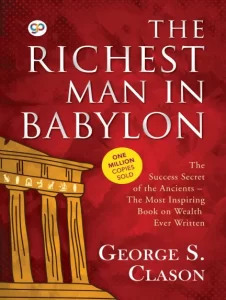The Richest Man in Babyl on is a book by George S. Clason that dispenses financial advice through a collection of parables set in ancient Babylon12. The book was published in 1926 and is considered a classic of personal financial advice1. The book covers topics such as how to plan financially for your life, how to deal with your personal wealth, and how this impacts your life3.
on is a book by George S. Clason that dispenses financial advice through a collection of parables set in ancient Babylon12. The book was published in 1926 and is considered a classic of personal financial advice1. The book covers topics such as how to plan financially for your life, how to deal with your personal wealth, and how this impacts your life3.
The parables are told by a fictional Babylonian character called Arkad, a poor scribe who became the “richest man in Babylon”. Included in Arkad’s advice are the “Seven Cures” (or how to generate money and wealth), and the “Five Laws of Gold” (or how to protect and invest wealth). A core part of Arkad’s advice is around “paying yourself first”, “living within your means”, “investing in what you know”, the importance of “long-term saving”, and “home ownership”.[1][2][3]
The content is from a series of pamphlets distributed by U.S. banks and insurance companies in 1920–24; the pamphlets were bound together and published as a book in 1926.[4][5] The book is often referred to as a classic of personal financial advice,[1][2] and appears in modern recommended reading lists on personal financial advice and wealth management,[6][7][8] which has kept the book in print almost 90 years after its first edition with over 2 million copies sold.[9][10]
Clason himself published an illustrated hardback edition in 1930 titled The Richest Man in Babylon and Other Stories which now sells for USD 1,250.[11]